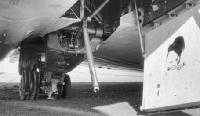Фотографии
-
Регистрационный номер: XH498 [10] Wrong place at the right time? - one of Peter Boyd’s remarkable photographs of XH498 coming in over the buses at the runway threshold, taken from the bank the massive bomber would hit moments later. Having moved his position slightly for the final touchdown, Peter avoided being hit by the mainwheels by a matter of inches.
Самолёты на фотографии: Avro Vulcan / Type 698 - Великобритания - 1952
-
Регистрационный номер: XA907 Still looking futuristic more than six decades after the type’s first flight, three Vulcans of the first B.1 production batch formate in line astern in their distinctive all-over anti-nuclear-flash white markings. The Vulcan B.1 entered frontline RAF service with No 83 Sqn at Waddington in May 1957.
Самолёты на фотографии: Avro Vulcan / Type 698 - Великобритания - 1952
-
Регистрационный номер: XH498 [10] Vulcan XH498 just about to clip the bank on final approach for its landing at Wellington Airport on October 25, 1959. Just visible on the bank beyond and to the left of the buses, beneath the Vulcan’s port main wheel bogie, is Peter Boyd, who had positioned himself to get some dramatic photographs to die for - very nearly literally.
Самолёты на фотографии: Avro Vulcan / Type 698 - Великобритания - 1952
-
Регистрационный номер: XH498 [10] Air Vice-Marshal John Davis, AOC No 1 Group, is greeted beside XH498 on arrival at RNZAF Ohakea on October 19, 1959. Note the two-star pennant and 617 Sqn badge on the fuselage of the Vulcan. Also part of the retinue was AOC-in-C Transport Command Sir Denis Barnett, who travelled in the Comet.
Самолёты на фотографии: Avro Vulcan / Type 698 - Великобритания - 1952
-
Регистрационный номер: XH553 A magnificent Avro photograph of the first production Vulcan B.2, XH553, showing its supremely elegant delta form above the clouds. The B.2 introduced a modified wing with an extended and cambered leading edge, which improved handling and performance at altitude, and the more powerful Olympus Series 200 powerplant.
Самолёты на фотографии: Avro Vulcan / Type 698 - Великобритания - 1952
-
Регистрационный номер: XH498 [10] Vulcan B.1 XH498 was one of 20 built in the second production batch, delivered between January 1958 and April 1959, and was one of the three sent on No 617 Sqn’s circumnavigation tour in 1959. It was also the one that came to grief during the Wellington Airport opening ceremony.
Самолёты на фотографии: Avro Vulcan / Type 698 - Великобритания - 1952
-
Регистрационный номер: XH498 [10], XH502 [2] The Vulcans of No 617 Sqn, including XH498 and XH502, at the SBAC Display at Farnborough in September 1960. On each display day a four-aircraft V-Force scramble kickstarted the show, the Vulcans performing on the Tuesday and Saturday, Valiants and Victors doing the honours on the other days.
Самолёты на фотографии: Avro Vulcan / Type 698 - Великобритания - 1952
-
Регистрационный номер: XH502 [2] It was left to XH502 to complete the circumnavigation tour, which concluded when the Vulcan landed back at Scampton on November 2, 1959. Later that year it participated in the four-aircraft scramble display at Farnborough, where it is seen here.
Самолёты на фотографии: Avro Vulcan / Type 698 - Великобритания - 1952
-
Регистрационный номер: XH498 [10] The stricken Vulcan roars away, streaming fuel and with the port mainwheel skewed 45° aft. In all the excitement, Smailes had forgotten to retract the airbrakes, which could have caused further problems...
Самолёты на фотографии: Avro Vulcan / Type 698 - Великобритания - 1952
-
Регистрационный номер: XH498 [10] ... which thankfully did not materialise, Smailes skilfully manhandling the aircraft to the RNZAF base at Ohakea, where it landed safely but ran off the runway, leaving a sizeable gouge in the grass in its wake.
Самолёты на фотографии: Avro Vulcan / Type 698 - Великобритания - 1952
-
Регистрационный номер: XH498 [10] Seconds after impact with the bank at the end of the runway, XH498’s undercarriage has buckled and snapped at the knuckle joint, forcing the mainwheel unit into the wing and rupturing the fuel tank. The port wingtip dragged the ground and was also damaged. The pilot, Tony Smailes, had no option but to open the throttles wide and hope for the best.
Самолёты на фотографии: Avro Vulcan / Type 698 - Великобритания - 1952
-
Регистрационный номер: XH498 [10] The crew evacuate XH498 through the cockpit and down the port wing moments after the aircraft had stopped at Ohakea. The fire crews are on hand and the hoses from the fire truck are already being run out.
Самолёты на фотографии: Avro Vulcan / Type 698 - Великобритания - 1952
-
Регистрационный номер: XH498 [10] The damaged port mainwheel unit after landing at Ohakea. The broken rod is visible, although the tyres appear to have survived the incident. The kiwi symbol was applied to the insides of both mainwheel doors on arrival in New Zealand. Vulcan XH498 was converted to B.1A configuration in 1962 with the addition of electronic countermeasures equipment and remained in service until October 1967, when it was given maintenance serial 7993M at Finningley and used - appropriately - as a crew escape trainer.
Самолёты на фотографии: Avro Vulcan / Type 698 - Великобритания - 1952
Статьи
- -
- ??? - Gone Fishin'!
- A.Tincopa - Wings over Peru
- B.Dunnell - Falklands confidential
- D.Gordon, I.Bott - Days of Thunder
- E.Wild - West Africa Wins Again ... or pigs can fly
- G.Alegi - ... a 350 lb Mystery
- J.Picarella, C.Koberg - Sunken treasure?
- J.Pote - A Close Shave at Wellington
- M.Garden - Oscar Garden the Sundowner of the Skies
- N.Stroud - The Last of the Many
- P.Davidson - Off the Beaten Track...
- P.Jarrett - Pioneering the Fighter (2)
- P.Vabre - Any port in a storm ... From Qantas Empire Airways
- R.Tisdale, A.Vercamer - Before & After












